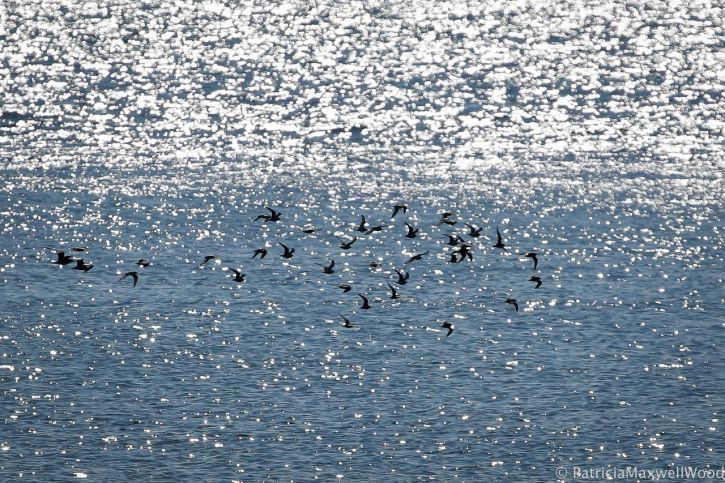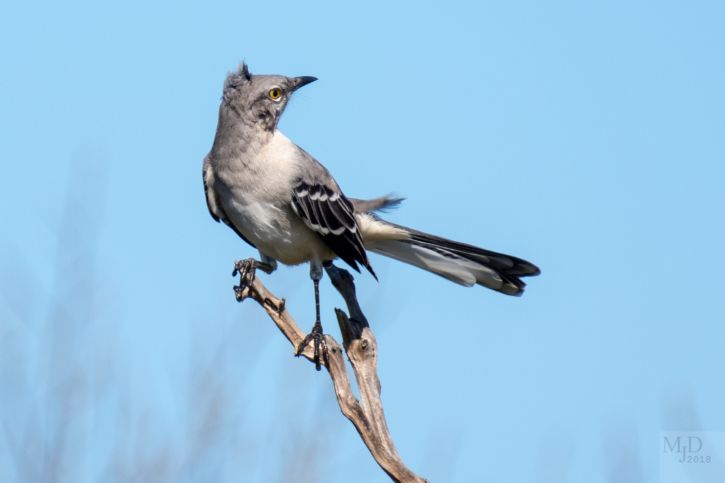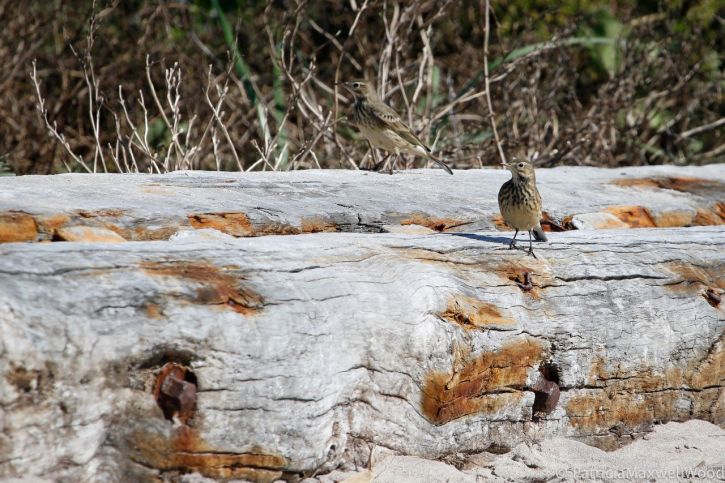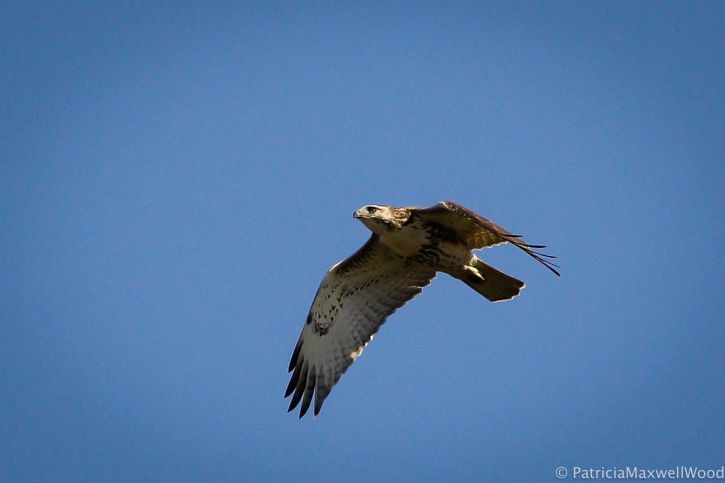This Wednesday seemed like a mix-up with some summer day, as it was so bright and sunny, nearing 85 degrees by the end of our outing. We went straight to the Parker River National Refuge’s parking lot #7. The idea was to try to see birds around the pile of boulders and cobble called Emerson Rocks before they were submerged by the tide. Emerson Rocks is what is left of a drumlin that the glacier left far enough off shore that the sea has removed small sediments, leaving stones that attract seabirds in winter. The pile also forms a protected area for seabirds to patrol for stray mollusks and fishes. Some of the first wintering seabirds were around. The sight of two Common Loons in basic plumage announced the season. Northern Gannets patrolled the deeper water offshore, along with distant and scattered scoters, none of which had white on the wings, so they were likely either Black or Surf Scoters. We await flocks of eiders and scoters foraging by the rocks though, and they were really only hinted at by two Common Eiders nearby.

Semipalmated and Black-bellied Plovers – Patti Wood
A knot of Dunlin, some Semipalmated plovers, and Sanderlings huddled on the beach, and more “SEPL’s” dashed by in a tight flock, joined by three Black-bellied Plovers. On dry land, several Northern Mockingbirds seemed to be in a skirmish in the shrubbery near the road, as they chatted at each other, and hurried back and forth. We kept hearing little chips coming from invisible warblers and sparrows. From the beach platform, we could see lots of dabbling ducks on Stage Island pool; most were clearly not Mallards or American Black Ducks. Vultures and a Northern Harrier went by. It all forced one to spin, trying to keep track.

Northern Mockingbird – Mike Densmore
We climbed up onto the tower overlooking Stage Island Pool, to work to identify some of the many eclipse ducks, meaning they had none or few of the marks that make them easy to identify in their colorful “alternate plumage.” The wind vibrated our scopes, the birds dabbled furiously, and some were definitely…well… “that one is a Gadwall!” The tiny ones were Green-winged Teal. “Ok, that group are American Wigeons, and that other group has the elegant necks of Northern Pintails.” Not one was going to make it easy. At least a Northern Harrier put on a show and rousted more drab ducks from the edges. While duck i.d. was more challenging than it will be when they molt into the courting plumage they sport for winter, it was good to see so many ducks finding food and cover in a managed pool on Plum Island.
Following a tip from Mary Margaret Halsey and Doug Chickering, we scurried down to Sandy Point in search of pipits. Arriving in the parking lot, we were cheered by a Yellow-rumped Warbler foraging in a shrub by the privy.

Yellow-rumped Warbler – Bob Minton
After enjoying this bird, we trotted out to the end of the boardwalk to find pipits. It didn’t take long. Little passerines flew about, saying “pipit” in high notes that cut through the sound of wind, surf, and chatting birders. It’s not a big sound, but is unmistakable. Then we spotted some of the birds walking about in the flat areas among the wrack and low vegetation. An effort to describe American Pipits ensued. “A sparrow with a warbler bill” was suggested. “A ‘warblerized’ thrush” said another. These ephemeral migrants are in good supply this fall, and gave us a good show.

American Pipits – Patti Wood
Next we went on to check on things at Hellcat, where few birds were about. A late Snowy Egret fished, and a young Red-tailed Hawk flew over. Many more dabbling ducks sat silhouetted on Bill Forward Pool.

Red-tailed Hawk – Patti Wood
We cut short our usual lingering ending of the outing on Hellcat Dike, and hurried over to the Wardens, where we could walk out to the dike that impounds North Pool, temporarily open to visitors in celebration of National Wildlife Refuge Week. It was rather hot by then, but the breeze from the west kept us cool, and it was lovely to poke around in the sparse cover for sparrows and other migrants. We found Yellow-rumped Warblers (heard), Song Sparrows, and Savannah Sparrows, but just as easily could have dug up a Clay-colored Sparrow or a White-crowned Sparrow as they are being seen on the Island now. A Belted Kingfisher boldly announced her right to fish at North Pool, at least until ice comes and pushes her south.

Belted Kingfisher – Mike Densmore
Canada Goose (25) – Stage Island Pool (SIP) – ~ 15, South Pannes – ~10.
Gadwall (8-10) – SIP.
American Wigeon (20+) – SIP.
American Black Duck – common.
Mallard – common.
Northern Pintail (15+) – SIP.
Green-winged Teal – common.
Common Eider (2) – Emerson Rocks
Scoter sp. (~12) – parking lot #7 (seven) ocean
Common Loon (2) – Emerson Rocks
Northern Gannet (4) – seven ocean
Double-crested Cormorant – common. Many large, migrating flocks.
Great Blue Heron (3) – North Marsh.
Great Egret (20+) – various, but concentrated between Cross Farm hill and Stage Island.
Snowy Egret (1) – North Pool from Hellcat Dike.
Turkey Vulture (8) – various.
Osprey (1) – North Pool.
Northern Harrier (1) – SIP.
Red-tailed Hawk (2) – Hellcat Dike and North Pool Overlook.
Black-bellied Plover (3) – seven beach.
Semipalmated Plover (20+) – seven beach.
Greater Yellowlegs (2) South Pannes.
Sanderling (5) – seven beach.
Dunlin (~20) – seven beach.
Semipalmated Sandpiper (1) – flyover Wardens.
Ring-billed Gull (at least 1) – seven beach.
Herring Gull – common.
Great Black-backed Gull (~5) – seven beach, Sandy point.
Rock Pigeon – “university streets” neighborhood.
Belted Kingfisher (1) – North Pool.
Eastern Phoebe (1) – North Pool Dike.
Blue Jay – common. Migrants?
American Crow (2)
American Robin (4) – Hellcat.
Northern Mockingbird – common. At least six at seven.
European Starling
Cedar Waxwing (2) – roadside.
American Pipit (8+) – Sandy Point near boardwalk. Probably many more.
Yellow-rumped Warbler (4) – various.
Savannah Sparrow – (1) – Wardens.
Song Sparrow (5) – various.
Northern Cardinal (2) – North Dunes thickets.

